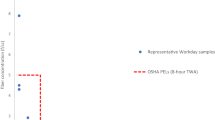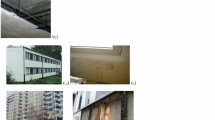Abstract
For decades, asbestos-containing gaskets were used in virtually every system that involved the transport of fluids or gases. Prior to the mid-1970s, some automobile exhaust systems contained asbestos gaskets either at flanges along the exhaust pipes or at the exhaust manifolds of the engine. A limited number of automobile mufflers were lined with asbestos paper. This paper describes a simulation study that characterized personal and bystander exposures to asbestos during the removal of automobile exhaust systems (ca. 1945–1975) containing asbestos gaskets. A total of 16 pre-1974 vehicles with old or original exhaust systems were studied. Of the 16 vehicles, 12 contained asbestos gaskets in the exhaust system and two vehicles had asbestos lining inside the muffler. A total of 82 samples (23 personal, 38 bystander, and 21 indoor background) were analyzed by Phase Contrast Microscopy (PCM) and 88 samples (25 personal, 41 bystander, and 22 indoor background) by Transmission Electron Microscopy (TEM). Only seven of 25 worker samples analyzed by TEM detected asbestos fibers and 18 were below the analytical sensitivity limit (mean 0.013 f/cc, range 0.001–0.074 f/cc). Applying the ratio of asbestos fibers:total fibers (including non-asbestos) as determined by TEM to the PCM results showed an average (1 h) adjusted PCM worker exposure of 0.018 f/cc (0.002–0.04 f/cc). The average (1 h) adjusted PCM airborne concentration for bystanders was 0.008 f/cc (range 0.0008–0.015 f/cc). Assuming a mechanic can replace four automobile single exhaust systems in 1 workday, the estimated 8-h time-weighted average (TWA) for a mechanic performing this work was 0.01 f/cc. Under a scenario where a mechanic might repeatedly conduct exhaust work, these results suggest that exposures to asbestos from work with automobile exhaust systems during the 1950s through the 1970s containing asbestos gaskets were substantially below 0.1 f/cc, the current PEL for chrysotile asbestos, and quite often were not detectable.
This is a preview of subscription content, access via your institution
Access options
Subscribe to this journal
Receive 6 print issues and online access
$259.00 per year
only $43.17 per issue
Buy this article
- Purchase on Springer Link
- Instant access to full article PDF
Prices may be subject to local taxes which are calculated during checkout



Similar content being viewed by others
References
ASHRAE. Heating, Ventilation, and Air-conditioning Applications, Inch-Pound Edition. American Society of Heating, Refrigerating and Air-Conditioning Engineers, Inc., Atlanta, GA, 1991.
ATSDR. Toxicological Profile for Asbestos. US Department of Health and Human Services (DHHS), Public Health Service, Agency for Toxic Substances and Disease Registry (ATSDR), Atlanta, GA, 2001.
Boelter F., Crawford G., and Podraza D. Airborne fiber exposure assessment of dry asbestos-containing gaskets and packings found in intact industrial and maritime fittings. Am Ind Hyg Assoc J 2002: 63: 732–740.
Brown D., and Gordon A. Past, present and future of the automotive gasket industry. Soc Auto Engineer (SAE) 1980: 800268: 11–20.
Cheng R., and McDermott H. Exposure to asbestos from asbestos gaskets. Appl Occup Environ Hyg 1991: 6: 588–591.
Fowler D. Exposures to asbestos arising from bandsawing gasket material. Appl Occup Environ Hyg 2000: 15: 404–408.
Kelleher D., and Bartlett W. Asbestos packings and gaskets. In: Proceedings of the Technical Association of the Pulp and Paper Industry (TAPPI). Engineering Conference. Tappi Press, Atlanta, GA, 1983, pp. 421–434, ISSN 0272–7269.
Liukonen L., Still K., and Beckett R. Asbestos Exposure from Gasket Operations. Naval Regional Medical Center, Occupational & Environmental Health Service, Bremerton, WA, 1978.
Longo W., Egeland W., Hatfield R., and Newton L. Fiber release during the removal of asbestos-containing gaskets: a work practice simulation. Appl Occup Environ Hyg 2002: 17: 55–62.
Mangold C. The Actual Occupational Contribution of Garlock Asbestos Gasket Material to the Occupational Exposure of Asbestos Workers. Environmental Control Sciences, Inc., Bellevue, WA, 1982a.
Mangold C. The Actual Occupational Exposure to Airborne Asbestos Released by Garlock Spiral Wound, Braided, and Encapsulated Gaskets. Environmental Control Sciences, Inc., Bellevue, WA, 1982b.
Mangold C. The Actual Contribution of Asbestos Fiber Exposure during Gasket Removal from Pipe Flanges Aboard Ship. Environmental Control Sciences, Inc., Bellevue, WA, 1983.
Mangold C. The Actual Release of Asbestos Fibers from New, Used, and Flanged Garlock Inc. Asbestos Gasket Materials. Environmental Control Sciences, Inc., Bellevue, WA, 1985.
Mangold C. The Actual Contribution of Airborne Asbestos Fibers to the Occupational Exposure of By-standers during Selected Processing of Encapsulated Asbestos Gaskets: Cutting Gaskets with a Circular Cutter. Environmental Control Sciences, Inc., Bellevue, WA, 1989a.
Mangold C. The Actual Contribution of Airborne Asbestos Fibers to the Occupational Exposure of By-standers during Selected Processing of Encapsulated Asbestos Gaskets: Flange Face Scraping with Putty Knife. Environmental Control Sciences, Inc., Bellevue, WA, 1989b.
Mangold C. The Actual Contribution of Airborne Asbestos Fibers to the Occupational Exposure of By-standers during Selected Processing of Encapsulated Asbestos Gaskets: Gasket Cutting with ball Peen Hammer. Environmental Control Sciences, Inc., Bellevue, WA, 1989c.
Mangold C. The Actual Contribution of Airborne Asbestos Fibers to the Occupational Exposure of By-standers during Selected Processing of Encapsulated Asbestos Gaskets: Gasket Cutting with Hand Shears. Environmental Control Sciences, Inc., Bellevue, WA, 1989d.
Mangold C. The Actual Contribution of Airborne Asbestos Fibers to the Occupational Exposure of By-standers during Selected Processing of Encapsulated Asbestos Gaskets: Hand Wire Brushing of Asbestos Gasket Residual from Flanges. Environmental Control Sciences, Inc., Bellevue, WA, 1989e.
Mangold C. The Actual Contribution of Airborne Asbestos Fibers to the Occupational Exposure of By-standers During Selected Processing of Encapsulated Asbestos Gaskets: Opening of Old Flanges and Removal of Asbestos Gaskets. Environmental Control Sciences, Inc., Bellevue, WA, 1989f.
Mangold C. The Actual Contribution of Airborne Asbestos Fibers to the Occupational Exposure of By-standers during Selected Processing of Encapsulated Asbestos Gaskets: Power Wire Brushing of Flange Faces. Environmental Control Sciences, Inc., Bellevue, WA, 1989g.
Mangold C. The Actual Contribution of Airborne Asbestos Fibers to the Occupational Exposure of By-standers during selected Processing of Encapsulated Asbestos Gaskets: Scribing of Gasket Materials. Environmental Control Sciences, Inc., Bellevue, WA, 1989h.
McKinnery W., and Moore R. Evaluation of airborne asbestos fiber levels during removal and installation of valve gaskets and packing. Am Ind Hyg Assoc J 1992: 53: 531–532.
NIOSH. Asbestos by PCM; 7400. National Institute for Occupational Safety and Health, DHHS (NIOSH) Publication No. 94–113 (1994), 1994a.
NIOSH. Asbestos by TEM; 7402. National Institute for Occupational Safety and Health, DHHS (NIOSH) Publication No. 94–113 (1994), 1994b.
Spence S., and Rocchi P. Exposure to asbestos fibres during gasket removal. Ann Occup Hyg 1996: 40: 583–588.
Spencer J. Exposure Assessment: an Evaluation of the Actual Contribution of Airborne Asbestos Fibers from the Removal and Installation of Gaskets and Packing Material. Environmental Profiles, Inc., Baltimore, MD, 1998.
US EPA. World Trade Center Background Study Report Interim Final. US Environmental Protection Agency. Prepared for United States Federal Emergency Management Agency, Washington D.C., 2003 (IAG No. EMW-2002-IA-0127. April).
Acknowledgements
This work was supported by funding from Daimler Chrysler, Ford Motor Company, and General Motors Corporation, who have been and are involved in litigation related to the exposure of mechanics. Some of the authors have served as expert witnesses in litigation regarding the potential asbestos health hazards to mechanics historically involved in automobile repair work.
Author information
Authors and Affiliations
Corresponding author
Appendix A
Appendix A
The results determined by PCM and TEM for each sample are provided in Appendix Table 1A.
Rights and permissions
About this article
Cite this article
Paustenbach, D., Madl, A., Donovan, E. et al. Chrysotile asbestos exposure associated with removal of automobile exhaust systems (ca. 1945–1975) by mechanics: Results of a simulation study. J Expo Sci Environ Epidemiol 16, 156–171 (2006). https://doi.org/10.1038/sj.jea.7500450
Received:
Accepted:
Published:
Issue Date:
DOI: https://doi.org/10.1038/sj.jea.7500450
Keywords
This article is cited by
-
Chrysotile and rock wool fibers induce chromosome aberrations and DNA damage in V79 lung fibroblast cells
Environmental Science and Pollution Research (2018)
-
High emission reduction performance of a novel organic-inorganic composite filters containing sepiolite mineral nanofibers
Scientific Reports (2017)



